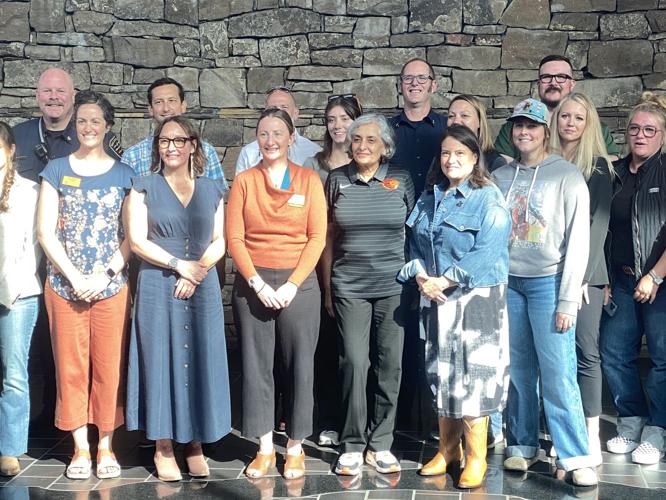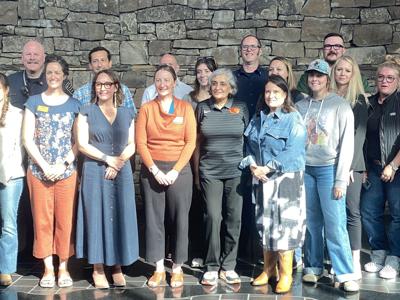WASCO CO. — Wasco County’s planning department received a $6 million Community Wildfire Defense Grant in 2024 to fund fire risk reduction over five years in vulnerable south county communities.
The money comes from the Bipartisan Infrastructure law signed by then President Biden in 2021, administered by the U.S. Forest Service.
The first six months went well, meeting or exceeding planners’ goals.
Oregon State University’s (OSU) President Jayathi Murthy visited Columbia Gorge Discovery Center in September to meet with fire professionals, many from OSU’s own Fire Extension Service, an important grant partner.
“Fire has always been part of this landscape,” EJ Davis, director of the OSU Fire Extension Program, told the crowd.
But bigger, hotter wildfires pop up almost every year now. Because of fire suppression, drought, and climate change, fire risk is rising through the roof.
“We are one of the highest risk counties in the state in terms of wildfire. Our ranchers know that. Our farmers know that,” Davis said. Dry summers, strong winds and steep canyons lead to “pretty extreme” fire behavior.
In 2019, House Bill 5050 added funds to OSU Extension’s budget for fire resistance and resilience. The program’s $1 million annual budget supports six regional fire specialists with expertise in topics like fire ecology, rangeland management, home hardening and prescribed fire.
Wasco is “largely unmapped and includes a lot of diverse ecologies, from moist mixed conifer forest up on Mount Hood, to that really special oak and pine savannah ... to sagebrush steppe,” said county Regional Fire Specialist Kayla Bordeson.

“Wasco is a place that’s shaped by fire across all of these different ecologies, and in the absence of that fire over the last 200 years, coupled with a lot of other changes — land use changes related to agriculture and the timber industry; changes in our climate that have produced a lot of stress on our vegetation through drought, insect and disease; invasive species; and just changes in species composition of native species, we are seeing more fire and different kinds of fire.”
Mt. Hood National Forest is now one of 21 national priority landscapes for wildfire crisis strategy, said Andrew Spaede.
Fires descend from public lands to singe private property and small towns on the slopes of Mount Hood. Ponderosa pines, weakened by climate change, drought and disease, are dying in droves to create high fuel loads near the small communities of Pine Hollow, Tygh Valley, Wamic and Pine Grove. In Maupin, fires rise from the Deschutes canyon, buoyed by hot summer winds.
The grant was awarded to fulfill a county-wide Community Wildfire Protection Plan, developed via 18 months of collaboration with local landowners, homeowners, renters and other stakeholders.
Wasco County Planning Department received the grant and manages the back-end paperwork. Oregon State Fire Marshal helped secure the grant, despite not getting any money from it.
Oregon Department of Forestry, Wasco County Soil and Water, and OSU Fire Extension Service employees help do the work, alongside local fire departments.
The work is focused on fire-vulnerable populations — elders, low-income residents who maybe can’t afford fire preparedness, people with transportation issues, language barriers, accessibility.
Funded by the grant, the group’s hosting community education events; publishing a quarterly newsletter; performing dozens of defensible space assessments, and performing the work prescribed in those assessments; reducing fuels on public and private lands; and turning roads into fuel breaks. Communities in South Wasco are forming wildfire defense cooperatives, and appointing neighborhood ambassadors, for the first time ever.
Workers are masticating, burning, and spraying away heavy fuel accumulations in the woods. They’ve removed some 151 hazard trees for free, with another 25 on the chopping block and 38 more landowners on a waiting list. Some 23 miles of road in Tygh Valley were groomed into fire breaks.
Staff from multiple agencies have checked satellite data for 100,000 acres of private property, identifying places that need more urgent fuels reduction, and then (with landowner permission) checked their data from the ground. Each south Wasco landowner will get a report.
In her grant-funded position as coordinator, Melissa Napoli serves as the hub of communication for all these separate efforts, agencies, and stakeholders. “One of the things that I’ve learned is that wildfire practitioners don’t often question the value of the work that they do. They don’t often ask, ‘Why the devastation that we’ve seen in Rowena.’ They’ve seen that before,” she said.
“... So they don’t have to ask why. That’s not the question. The question that they ask is, ‘How? How am I ever going to reach people? How am I ever going to be able to do more when my plate is already overflowing? How are we ever going to build a program that’s big enough, that its impact can be felt both in nature and in neighborhood?’”
Working together is her solution, connecting the power of communities, agencies, and people on the ground. Together, the grant partners accomplish much more than working separately.
“We’re bringing together people who have really different ideological interests and values, but they can sit down at a table, we can go out the woods together, and we can develop real solutions,” Andrew Spaede said. Their work will never be finished. Vegetation always grows back; prescribed burns are always needed.
The county is applying for another $2.7 million to do the same work at Rowena, Chenowith, and Sevenmile Hill.

























Commented
Sorry, there are no recent results for popular commented articles.